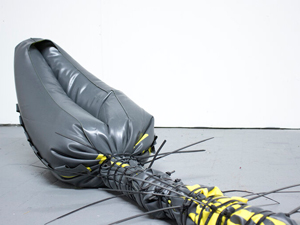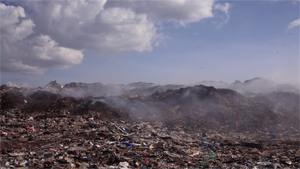Disaster Areas
John Haberin New York City
Madeline Hollander, Jacob Kirkegaard, and Bat-Ami Rivlin
Madeline Hollander takes comfort in the sound of a cricket's wings. What, though, if the crickets have gone silent? What, too, if it is just one sign of an unfolding global disaster?
Landscapes for Jacob Kirkegaard can look untouched by human hands or irrecoverably polluted. One might never know that he is tracking not just natural processes or human ones, but human attention to the future of the earth. He never mentions global warming, but one might still imagine having entered forces out of natural or human control thanks to sound art and new media. Bat-Ami Rivlin has entered a disaster area, too, but also a recreation area, and she brings the equipment to handle either one. For all three artists, the planet might be on its deathbed, but as a living thing. So, too, might art. 
Where the cricket sings
I have grown so dependent on the phone's weather app that, without it, I might never feel the morning air again. I should trust again to nature. Madeline Hollander does, as she listens for a cricket's wings. It tells her the temperature—and the fate of the ecosystem. It teaches her how much she had taken for granted a simple chirp and a hectic dance. It teaches her, too, how much she and the earth have to lose.
Like William Butler Yeats more than a century ago, Hollander retreated from the bustle of civilization to find peace. Like him, too, she imagines it "dropping from the veils of the morning to where the cricket sings." She spent five nights in the Kauai island rainforest in Hawaii, but even there civilization intrudes. Flatwing crickets, she knew, have evolved silence to hide from predators. Even then, she caught not a single one. Have human intervention and climate change or just the course of time driven them to extinction and unemployment or reduced human beings to foragers, and can artists keep up half as well as Rachel Rosheger in digital media?
For the record, she can calculate the temperature by counting the chirps in fourteen seconds and adding forty. That factoid opens Flatwing, a video at the Whitney bathed in the purple and orange light of her infrared camera. She catches a chicken looking thoroughly unappetizing as it struggles to do whatever chickens do in the wild. She catches other insects barely feeling their way. She engages in what sounds like primitive radio communication with a collaborator, to get it all on record. But nope, no crickets.
Not that Hollander thinks of herself as a field biologist, although her natural histories bridge science and art. Sketches out front reflect the thorough but quirky reasoning of an artist. They chart cricket morphology (which is to say form and structure), behavior, and development. Its lifespan finds its climax in a successive mating dance and death dance, and that is what caught her attention in the first place. She was working with a dance company for a second video, New Max—which a curator compares to photographs of dance by Irving Penn. She calls herself a choreographic researcher.
Who knew that such a thing existed? But then who can deny the human appeal of insect dancers torn between sex and death? With a call-out to John Cage, who can resist sound art about silence? Silent crickets still rub their wings together to attract mates, just as their noisier counterparts use their wings to chirp. Hollander calls this miming a kind of ventriloquism, as if nature were in on the act. Like Yeats yet again, one cannot know the dancers from the dance.
A video that cannot locate its subject can only be provocative, but at a cost. It seems all but shapeless. Although lush in color when it turns its eye on insects and vegetation, it lingers most on the artist and her insistent talk. Text screens in the style of old teletype machines feel like dull visual interruptions. (Their block capitals in red on black are also a strain to read.) Still, I shall be happy if it all allows, in people or in insects, the dance to resume.
Dirty hands
Jacob Kirkegaard sure gets his hands dirty. He has drowned microphones in toxic wastewater and contaminated rivers (heavily contaminated, he insists). He has lowered sensors into organic waste and incinerators. The very darkness of his surround sound replicates the experience on eight channels, and he calls it a sound sculpture rather than installation as if to insist on its palpable reality. It requires a descent into the basement at that. Dive right in.
You might be doing the earth a favor if you do—or at least getting to know the work of others cleaning up after you. Kirkegaard's project has taken him to a monster landfill in Kenya, but also to a wastewater treatment plant in Latvia and a recycling center in Denmark. He has recorded echoes reflecting from metal, glass, and plastic, some of it sorted by machine and some by hand. Whatever it takes. The very breadth of his travels underscores his concern for the planet. From its pulsations alone, it seems very much alive.
 Kirkegaard has had a dual concern for organic sound and environmental hazards for some time now, and he hardly distinguishes the two. Past projects have taken him to Chernobyl in the process of recovery and to a human inner ear. Neither is altogether filthy or comforting. He just wants to offer a living testimony or, in the work's title, Testimonium. At a given moment, it can sustain a barely audible click or build to a tremendous roar. Stick around, if you dare.
Kirkegaard has had a dual concern for organic sound and environmental hazards for some time now, and he hardly distinguishes the two. Past projects have taken him to Chernobyl in the process of recovery and to a human inner ear. Neither is altogether filthy or comforting. He just wants to offer a living testimony or, in the work's title, Testimonium. At a given moment, it can sustain a barely audible click or build to a tremendous roar. Stick around, if you dare.
You can think of recycling and treatment as artificial means to a second nature, and so is art. Back upstairs, a wide-screen video drives home the point. Wiggling black scratches on a white field might pass for signs of life in fresh-fallen snow. Darker torrents suggest rocky landscapes, forests, or oceans, like ripples in the Atlantic for Rindon Johnson. They look dangerous and desolate, but not simply contaminated. The suggestion is all the more obvious in a still photograph. New media add only a sense of scale and constant change.
Like their Latin title, they can also seem monotonous and pretentious. So does Kirkegaard, who claims to have made his first sound art at age six. I can only imagine the pride he must take in practically sharing his name with the Danish philosopher of Fear and Trembling. For what it is worth, I loved the book, which retells the Old Testament god's demand on Abraham to sacrifice his son, Isaac. The father does so sadly but willingly, not despite but because it is absurd. As with climate change and pollution, nature and humanity make unacceptable but necessary demands.
How real is this virtual reality? The gallery, generously, posts a full twenty-five minutes online for the duration of the show (headphones encouraged). It makes a timely follow-up to an installation not so very far away, in Soho. For the New York Earth Room in 1977, Walter de Maria and the Dia Foundation made even dirt look squeaky clean, and it looks even cleaner today. But then this was a time of Minimalism and the soil of Robert Smithson's Spiral Jetty in the Great Salt Lake—and the ancestor of Dia:Beacon. New York itself is not as dirty or dangerous now, but the planet is still catching up.
Abandon ship
I felt lucky to have caught "No Can Do" on its first afternoon, with the artist present. Bat-Ami Rivlin was very much relaxed and alive. One might well wonder from the work. It looks as if it had lost the ability to sustain life, just when she or the viewer needs it most. Not that the show's title is an expression of despair, but rather a knowing shrug. Materials like these, she implies, have earned it.
I mistook the central components of the show's first work for life jackets—or, if not, for lifeboats deployed only in an emergency. They were plainly inflatable, at least before Rivlin got ahold of them. Their garish yellow gives the alert, at sea or at a construction site. Their disposable plastic, torn and half buried in black, seems hardly meant for much else. Two more samples in the back room have survived a little plumper and more intact, their dark gray connected by a gray and yellow pole wrapped in zip ties. Hey, something has to hold this together, if only art.
They are actually fragments of kayaks—sport for those who welcome shallow, choppy waters and a sense of danger. And the work in back, its pole framed by two tapered rectangles, has roughly the shape of a two-headed oar. Paddle away, if you dare. I myself think of kayaks more as Inuit craft in wood, with a history, in cold suiting yet another nasty New York winter. Rivlin makes a point, though, of a culture and economy that have left such things behind, in favor of the cheap and dysfunctional. Things here will no longer do.
An upright chain-link fence looks no more comforting, quite apart from its original purpose for exclusion. Frail as it is, with a few bedsprings sticking out here and there, it looks more like the innards of a mattress. One cannot lie down on it, and the attached bit of fabric will not serve as covering. Two other works, thin metal rods bent into circles and closed by short hooks, seem about to spring back. I have no clue what purpose they once served, but ka-boing. And that is about it.
The gallery leans toward spare shows of found objects that make one wonder whether an installation is still in progress. Not like or Ward Shelley and Douglas Paulson or Andrew Ohanesian, who give a gallery the illusion of a crime scene or a place for rent—but just, say, a vacuum cleaner not quite able to clean house. In the case of Rivlin, it seems easier to say what her appropriation art is not. It has neither the refusal of art in Dada nor the embrace of art in the "combine paintings" of Robert Rauschenberg. It lacks the comic sense of discovery in his juxtaposition of materials, like a tire around the neck of a ghost. It does not transform industrial materials into formalism and abstraction, like Donald Judd.
I cannot even say that Rivlin's finds have become something familiar and new, unless a near circle counts. Nor am I convinced by the critique of capitalism, however warranted. The Israeli-born artist is too detached for a fight to build a better world. Subtitles spell out her materials, and each thing is what it is. Something can feel missing in work best defined by negatives, but art for some time has been after the thing in itself. This is only a kayak, but it defies you to abandon ship.

Madeline Hollander ran at The Whitney Museum of American Art through August 8, 2021, Jacob Kirkegaard at Fridman through March 27, and Bat-Ami Rivlin at M 23 through March 21.




